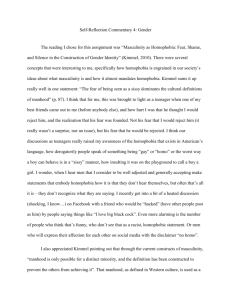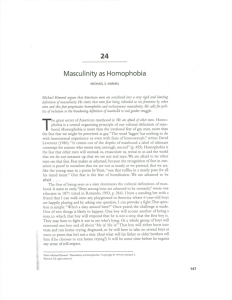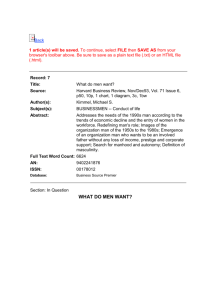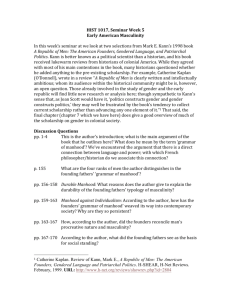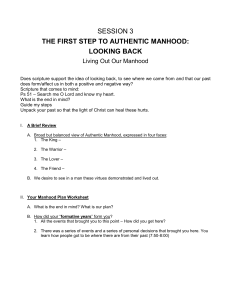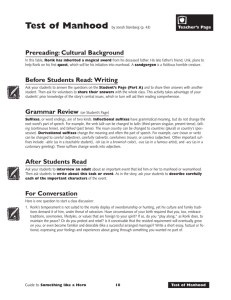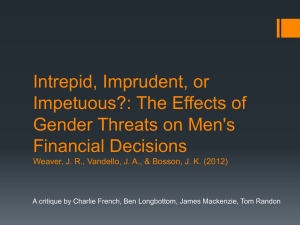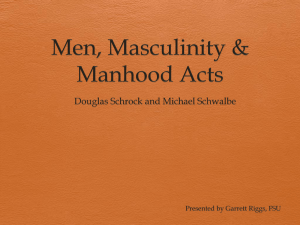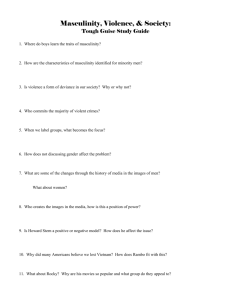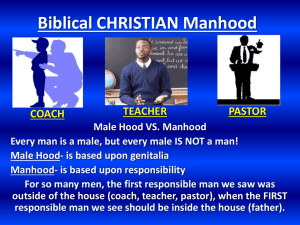Masculinity as Homophobia
advertisement
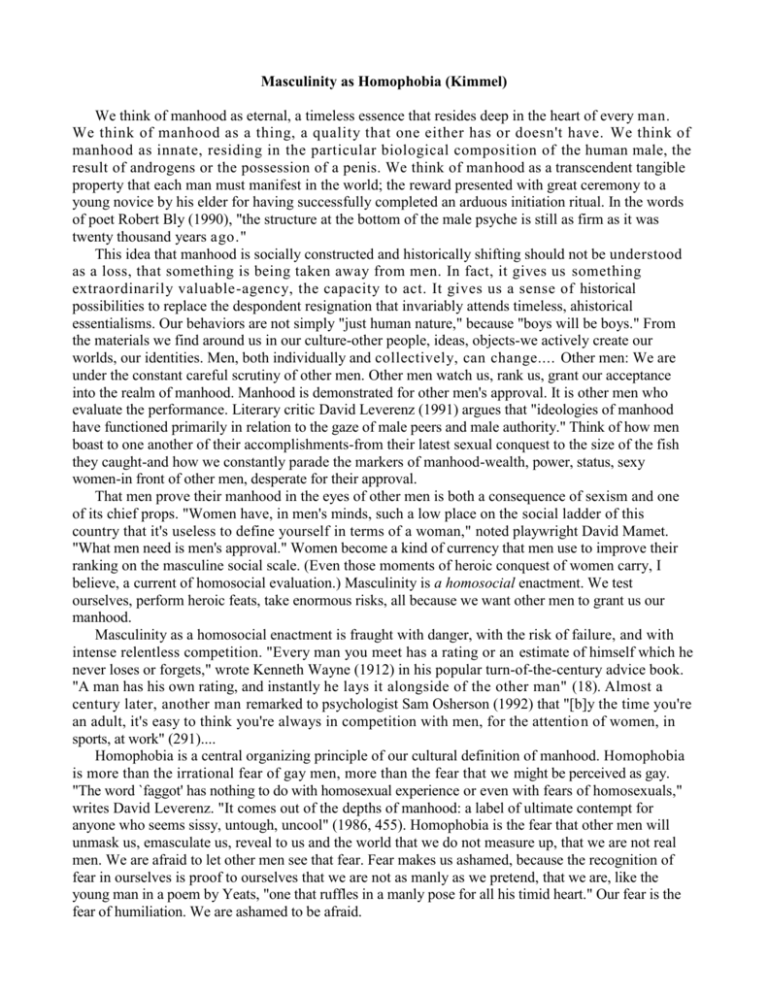
Masculinity as Homophobia (Kimmel) We think of manhood as eternal, a timeless essence that resides deep in the heart of every man. We think of manhood as a thing, a quality that one either has or doesn't have. We think of manhood as innate, residing in the particular biological composition of the human male, the result of androgens or the possession of a penis. We think of manhood as a transcendent tangible property that each man must manifest in the world; the reward presented with great ceremony to a young novice by his elder for having successfully completed an arduous initiation ritual. In the words of poet Robert Bly (1990), "the structure at the bottom of the male psyche is still as firm as it was twenty thousand years ago." This idea that manhood is socially constructed and historically shifting should not be understood as a loss, that something is being taken away from men. In fact, it gives us something extraordinarily valuable-agency, the capacity to act. It gives us a sense of historical possibilities to replace the despondent resignation that invariably attends timeless, ahistorical essentialisms. Our behaviors are not simply "just human nature," because "boys will be boys." From the materials we find around us in our culture-other people, ideas, objects-we actively create our worlds, our identities. Men, both individually and collectively, can change.... Other men: We are under the constant careful scrutiny of other men. Other men watch us, rank us, grant our acceptance into the realm of manhood. Manhood is demonstrated for other men's approval. It is other men who evaluate the performance. Literary critic David Leverenz (1991) argues that "ideologies of manhood have functioned primarily in relation to the gaze of male peers and male authority." Think of how men boast to one another of their accomplishments-from their latest sexual conquest to the size of the fish they caught-and how we constantly parade the markers of manhood-wealth, power, status, sexy women-in front of other men, desperate for their approval. That men prove their manhood in the eyes of other men is both a consequence of sexism and one of its chief props. "Women have, in men's minds, such a low place on the social ladder of this country that it's useless to define yourself in terms of a woman," noted playwright David Mamet. "What men need is men's approval." Women become a kind of currency that men use to improve their ranking on the masculine social scale. (Even those moments of heroic conquest of women carry, I believe, a current of homosocial evaluation.) Masculinity is a homosocial enactment. We test ourselves, perform heroic feats, take enormous risks, all because we want other men to grant us our manhood. Masculinity as a homosocial enactment is fraught with danger, with the risk of failure, and with intense relentless competition. "Every man you meet has a rating or an estimate of himself which he never loses or forgets," wrote Kenneth Wayne (1912) in his popular turn-of-the-century advice book. "A man has his own rating, and instantly he lays it alongside of the other man" (18). Almost a century later, another man remarked to psychologist Sam Osherson (1992) that "[b]y the time you're an adult, it's easy to think you're always in competition with men, for the attentio n of women, in sports, at work" (291).... Homophobia is a central organizing principle of our cultural definition of manhood. Homophobia is more than the irrational fear of gay men, more than the fear that we might be perceived as gay. "The word `faggot' has nothing to do with homosexual experience or even with fears of homosexuals," writes David Leverenz. "It comes out of the depths of manhood: a label of ultimate contempt for anyone who seems sissy, untough, uncool" (1986, 455). Homophobia is the fear that other men will unmask us, emasculate us, reveal to us and the world that we do not measure up, that we are not real men. We are afraid to let other men see that fear. Fear makes us ashamed, because the recognition of fear in ourselves is proof to ourselves that we are not as manly as we pretend, that we are, like the young man in a poem by Yeats, "one that ruffles in a manly pose for all his timid heart." Our fear is the fear of humiliation. We are ashamed to be afraid. Shame leads to silence-the silence that keeps other people believing that we actually approve of the things that are done to women, to minorities, to gays and lesbians in our culture. The frightened silence as we scurry past a woman being hassled by men on the street. That furtive silence when men make sexist or racist jokes in a bar. That clammy handed silence when guys in the office make gay-bashing jokes. Our fears are the sources of our silences, and men's silence is what keeps the system running. This might help to explain why women often complain that their male friends or partners are often so understanding when they are alone and yet laugh at sexist jokes or even make those jokes themselves when they are out with a group. The fear of being seen as a sissy dominates the cultural definitions of manhood. It starts so early. "Boys among boys are ashamed to be unmanly," wrote one educator in 1871 (cited in Rotundo 1993, 264). 1 have a standing bet with a friend that I can walk onto any playground in America where 6-year-old boys are happily playing and by asking one question, I can provoke a fight. That question is simple: "Who's a sissy around here?" Once posed, the challenge is made. One of two things is likely to happen. One boy will accuse another of being a sissy, to which that boy will respond that he is not a sissy, that the first boy is. They may have to fight it out to see who's lying. Or a whole group of boys will surround one boy and all shout, "He is! He is!" That boy will either burst into tears and run home crying, disgraced, or he will have to take on several boys at once, to prove that he's not a sissy. (And what will his father or older brothers tell him if he chooses to run home crying?) It will be some time before he regains any sense of self-respect. Violence is often the single most evident marker of manhood. Rather it is the willingness to fight, the desire to fight. The origin of our expression that one "has a chip on one's shoulder" lies in the practice of an adolescent boy in the country or small town at the turn of the century, who would literally walk around with a chip of wood balanced on his shoulder-a signal of his readiness to fight with anyone who would take the initiative of knocking the chip off . As adolescents, we learn that our peers are a kind of gender police, constantly threatening to unmask us as feminine, as sissies. One of the favorite tricks when I was an adolescent was to ask a boy to look at his fingernails. If he held his palm toward his face and curled his fingers back to see them, he passed the test. He'd looked at his nails "like a man." But if he held the back of his hand away from his face, and looked at his fingernails with arm outstretched, he was immediately ridiculed as a sissy. As young men we are constantly riding those gender boundaries, checking the fences we have constructed on the perimeter, making sure that nothing even remotely feminine might show through. The possibilities of being unmasked are everywhere. Even the most seemingly insignificant thing can pose a threat or activate that haunting terror. On the day the students in my course "Sociology of Men and Masculinities" were scheduled to discuss homophobia and male-male friendships, one student provided a touching illustration. Noting that it was a beautiful day, the first day of spring after a brutal northeast winter, he decided to wear shorts to class. "I had this really nice pair of new Madras shorts," he commented. "But then I thought to myself, these shorts have lavender and pink in them. Today's class topic is homophobia. Maybe today is not the best day to wear these shorts." Our efforts to maintain a manly front cover everything we do. What we wear. How we talk. How we walk. What we eat. Every mannerism, every movement contains a coded gender language. Think, for example, of how you would answer the question: How do you "know" if a man is homosexual? When I ask this question in classes or workshops, respondents invariably provide a pretty standard list of stereotypically effeminate behaviors. He walks a certain way, talks a certain way, acts a certain way. He's very emotional; he shows his feelings. One woman commented that she "knows" a man is gay if he really cares about her; another said she knows he's gay if he shows no interest in her, if he leaves her alone. Now alter the question and imagine what heterosexual men do to make sure no one could possibly get the "wrong idea" about them. Responses typically refer to the original stereotypes, this time as a set of negative rules about behavior. Never dress that way. Never talk or walk that way. Never show your feelings or get emotional. Always be prepared to demonstrate sexual interest in women that you meet, so it is impossible for any woman to get the wrong idea about you. In this sense, homophobia, the fear of being perceived as gay, as not a real man, keeps men exaggerating all the traditional rules of masculinity, including sexual predation with women. Homophobia and sexism go hand in hand. The stakes of perceived sissydom are enormous-sometimes matters of life and death. We take enormous risks to prove our manhood, exposing ourselves disproportionately to health risks, workplace hazards, and stress-related illnesses. Men commit suicide three times as often as women.... In one survey, women and men were asked what they were most afraid of. Women responded that they were most afraid of being raped and murdered. Men responded that they were most afraid of being laughed at (Noble 1992,105-6). Homophobia is intimately interwoven with both sexism and racism. The fear-sometimes conscious, sometimes not-that others might perceive us as homosexual propels men to enact all manner of exaggerated masculine behaviors and attitudes to make sure that no one could possibly get the wrong idea about us. One of the centerpieces of that exaggerated masculinity is putting women down, both by excluding them from the public sphere and by the quotidian put-downs in speech and behaviors that organize the daily life of the American man. Women and gay men become the "other" against which heterosexual men project their identities, against whom they stack the decks so as to compete in a situation in which they will always win, so that by suppressing them, men can stake a claim for their own manhood. Women threaten emasculation by representing the home, workplace, and familial responsibility, the negation of fun. Gay men have historically played the role of the consummate sissy in the American popular mind because homosexuality is seen as an inversion of normal gender development. There have been other "others." Through American history, various groups have represented the sissy, the non-men against whom American men played out their definitions of manhood, often with vicious results. In fact, these changing groups provide an interesting lesson in American historical development. At the turn of the 19th century, it was Europeans and children who provided the contrast for American men. The "true American was vigorous, manly, and direct, not effete and corrupt like the supposed Europeans," writes Rupert Wilkinson (1986). "He was plain rather than ornamented, rugged rather than luxury seeking, a liberty loving common man or natural gentleman rather than an aristocratic oppressor or servile minion" (96). The "real man" of the early nineteenth century was neither noble nor serf. By the middle of the century, black slaves had replaced the effete nobleman. Slaves were seen as dependent, helpless men, incapable of defending their women and children, and therefore less than manly. Native Americans were cast as foolish and naive children, so they could be infantilized as the "Red Children of the Great White Father" and therefore excluded from full manhood. By the end of the century, new European immigrants were also added to the list of the unreal men, especially the Irish and Italians, who were seen as too passionate and emotionally volatile to remain controlled sturdy oaks, and Jews, who were seen as too bookishly effete and too physically puny to truly measure up. In the mid-twentieth century, it was also Asians-first the Japanese during the Second World War, and more recently, the Vietnamese during the Vietnam War-who have served as unmanly templates against which American men have hurled their gendered rage. Asian men were seen as small, soft, and effeminate-hardly men at all. Such a list of "hyphenated" Americans-Italian-, Jewish-, Irish-, African-, Native-, Asian-, gaycomposes the majority of American men. So manhood is only possible for a distinct minority, and the definition has been constructed to prevent the others from achieving it. Interestingly, this emasculation of one's enemies has a flip side and one that is equally gendered. These very groups that have historically been cast as less than manly were also, often simultaneously, cast as hypermasculine, as sexually aggressive, violent rapacious beasts, against whom "civilized" men must take a decisive stand and thereby rescue civilization. Thus black men were depicted as rampaging sexual beasts, women as carnivorously carnal, gay men as sexually insatiable, southern European men as sexually predatory and voracious, and Asian men as vicious and cruel torturers who were immorally disinterested in life itself, willing to sacrifice their entire people for their whims. But whether one saw these groups as effeminate sissies or as brutal uncivilized savages, the terms with which they were perceived were gendered. These groups become the "others," the screens against which traditional conceptions of manhood were developed. Being seen as unmanly is a fear that propels American men to deny manhood to others, as a way of proving the unprovable-that one is fully manly. Masculinity becomes a defense against the perceived threat of humiliation in the eyes of other men, enacted through a "sequence of postures"-things we might say, or do, or even think, that, if we thought carefully about them, would make us ashamed of ourselves (Savran 1992, 16). After all, how many of us have made homophobic or sexist remarks, or told racist jokes, or made lewd comments to women on the street? How many of us have translated those ideas and those words into actions, by physically attacking gay men, or forcing or cajoling a woman to have sex even though she didn't really want to because it was important to score? I have argued that homophobia, men's fear of other men, is the animating condition of the dominant definition of masculinity in America, that the reigning definition of masculinity is a defensive effort to prevent being emasculated. In our efforts to suppress or overcome those fears, the dominant culture exacts a tremendous price from those deemed less than fully manly: women, gay men, nonnative-born men, men of color. This perspective may help clarify a paradox in men's lives, a paradox in which men have virtually all the power and yet do not feel powerful (see Kaufman 1993). Manhood is equated with power-over women, over other men. Everywhere we look, we see the institutional expression of that power-in state and national legislatures, on the boards of directors of every major U.S. corporation or law firm, and in every school and hospital administration. Women have long understood this, and feminist women have spent the past three decades challenging both the public and the private expressions of men's power and acknowledging their fear of men. Feminism as a set of theories both explains women's fear of men and empowers women to confront it both publicly and privately. Feminist women have theorized that masculinity is about the drive for domination, the drive for power, for conquest. This feminist definition of masculinity as the drive for power is theorized from women's point of view. It is how women experience masculinity. But it assumes symmetry between the public and the private that does not conform to men's experiences. Feminists observe that women, as a group, do not hold power in our society. They also observe that individually, they, as women, do not feel powerful. They feel afraid, vulnerable. Their observation of the social reality and their individual experiences are therefore symmetrical. Feminism also observes that men, as a group, are in power. Thus, with the same symmetry, feminism has tended to assume that individually men must feel powerful. This is why the feminist critique of masculinity often falls on deaf ears with men. When confronted with the analysis that men have all the power, many men react incredulously. "What do you mean, men have all the power?" they ask. "What are you talking about? My wife bosses me around. My kids boss me around. My boss bosses me around. I have no power at all! I'm completely powerless. Men's feelings are not the feelings of the powerful, but of those who see themselves as powerless. These are the feelings that come inevitably from the discontinuity between the social and the psychological, between the aggregate analysis that reveals how men are in power as a group and the psychological fact that they do not feel powerful as individuals. They are the feelings of men who were raised to believe themselves entitled to feel that power, but do not feel it. No wonder many men are frustrated and angry. This may explain the recent popularity of those workshops and retreats designed to help men to claim their "inner" power, their "deep manhood," or their "warrior within." ... The dimension of power is now reinserted into men's experience not only as the product of individual experience but also as the product of relations with other men. In this sense, men's experience of powerlessness is real-the men actually feel it and certainly act on it-but it is not true, that is, it does not accurately describe their condition. In contrast to women's lives, men's lives are structured around relationships of power and men's differential access to power, as well as the differential access to that power of men as a group. Our imperfect analysis of our own situation leads us to believe that we men need more power, rather than leading us to support feminists' efforts to rearrange power relationships along more equitable lines. Philosopher Hannah Arendt (1970) fully understood this contradictory experience of social and individual power: Power corresponds to the human ability not just to act but to act in concert. Power is never the property of an individual; it belongs to a group and remains in existence only so long as the group keeps together. When we say of somebody that he is "in power" we actually refer to his being empowered by a certain number of people to act in their name. The moment the group, from which the power originated to begin with ... disappears, "his power" also vanishes. (44) Why, then, do American men feel so powerless? Part of the answer is because we've constructed the rules of manhood so that only the tiniest fraction of men come to believe that they are the biggest of wheels, the sturdiest of oaks, the most virulent repudiators of femininity, the most daring and aggressive. We've managed to disempower the overwhelming majority of American men by other means-such as discriminating on the basis of race, class, ethnicity, age, or sexual preference. Masculinist retreats to retrieve deep, wounded, masculinity are but one of the ways in which American men currently struggle with their fears and their shame. Unfortunately, at the very moment that they work to break down the isolation that governs men's lives, as they enable men to express those fears and that shame, they ignore the social power that men continue to exert over women and the privileges from which they (as the middle-aged, middle-class white men who largely make up these retreats) continue to benefit-regardless of their experiences as wounded victims of oppressive male socialization. Others still rehearse the politics of exclusion, as if by clearing away the playing field of secure gender identity of any that we deem less than manly-women, gay men, nonnative-born men, men of color-middle-class, straight, white men can reground their sense of themselves without those haunting fears and that deep shame that they are unmanly and will be exposed by other men. This is the manhood of racism, of sexism, of homophobia. It is the manhood that is so chronically insecure that it trembles at the idea of lifting the ban on gays in the military, that is so threatened by women in the workplace that women become the targets of sexual harassment, that is so deeply frightened of equality that it must ensure that the playing field of male competition remains stacked against all newcomers to the game. Exclusion and escape have been the dominant methods American men have used to keep their fears of humiliation at bay. The fear of emasculation by other men, of being humiliated, of being seen as a sissy, is the leitmotif in my reading of the history of American manhood. Masculinity has become a relentless test by which we prove to other men, to women, and ultimately to ourselves, that we have successfully mastered the part. The restlessness that men feel today is nothing new in American history; we have been anxious and restless for almost two centuries. Neither excl usion nor escape has ever brought us the relief we've sought, and there is no reason to think that either will solve our problems now. Peace of mind, relief from gender struggle, will come only from a politics of inclusion, not exclusion, from standing up for equality and justice, and not by running away.
